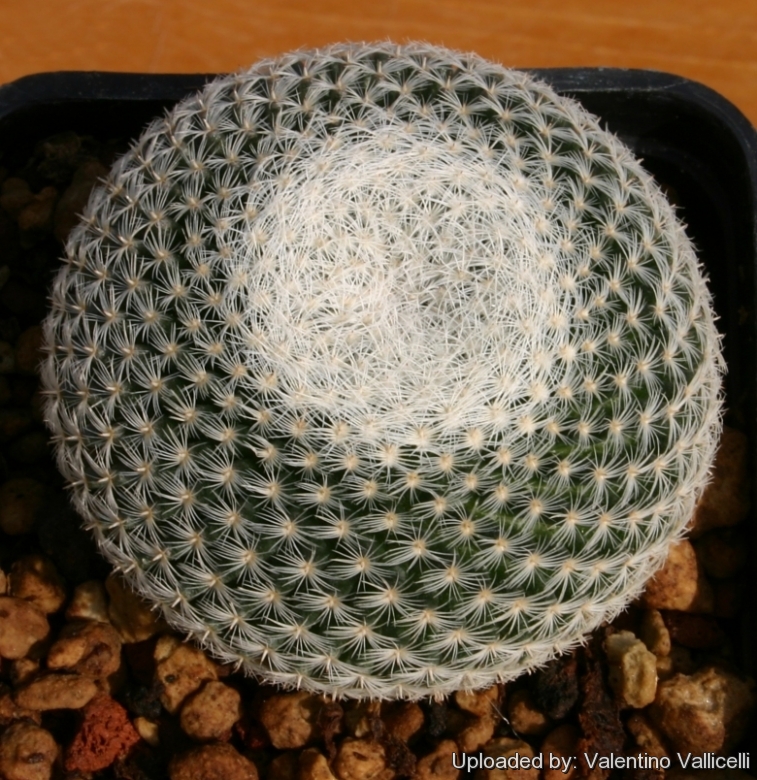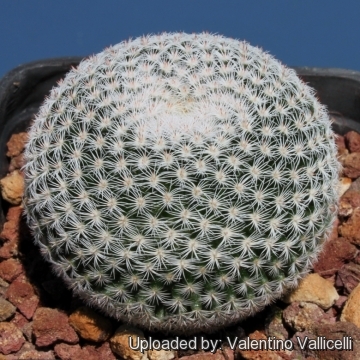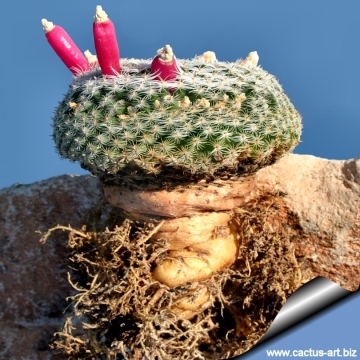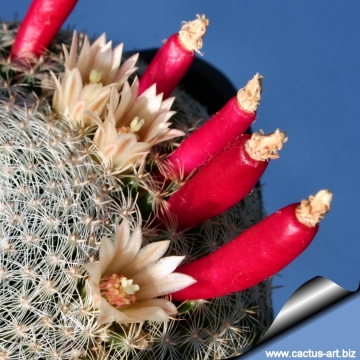= Mammillaria formosa subs. microthele var. superfina hort.
same as M. microthele var. superfina Schwarz Cat.: Mottram, 91
Accepted Scientific Name: Mammillaria formosa subs. microthele (Muehlenpf.) D.R.Hunt
Mammillaria Postscripts 6: 9 (1997)

Mammillaria microthele var. superfina (Mammillaria formosa subs. microthele var. superfina) Photo by: Valentino Vallicelli
SB34 (Collector: Steven (Steve) Brack) Locality: Presa de Guadalupe, San Luis Potosi, Mexico. This is a relatively tough and user-friendly small cactus with tight, dense minute
white spines that lie flat against the plant so not that dangerous.
Origin and Habitat: Mexico (Coahuila, San Luis Potosi, Tamaulipas).
Habitat: It is usually found in limestone slopes among shrubs of Agave lechuguillaSN|23013]]SN|23013]] and Hechtia glomerata. Altitude 1.000 - 2.200 m.
Synonyms:
See all synonyms of Mammillaria formosa
Common Names include:
ENGLISH: Owl Eye Cactus
SPANISH (Español): Cabeza blanca
Description: Slow-growing flattened plants, clumping with tight, short white spines, form low mounds in time
Stems: Almost discoidal to globose, apically depressed, dividing dichotomously, each stem are up to 6 cm in diameter.
Radial spines: 22 - 24 tiny, white and bristle-like that almost obscure the stem.
Flowers: Rings of small (5 mm) nearly pure white (Or with light pink midstipe ) are produced in spring over a several weeks period
Remarks: The so called “superfina” is a particular nice selected form with very small tubercles and spines.
Subspecies, varieties, forms and cultivars of plants belonging to the Mammillaria formosa group
 Mammillaria formosa Galeotti ex Scheidw.: has pale pink flowers and 20-22 white radial spines. Distribution: Coahuila, Aguascalientes, Guanajuato, Zacatecas, Tamaulipas, Nuevo Leon, and San Luis Potosi.
Mammillaria formosa Galeotti ex Scheidw.: has pale pink flowers and 20-22 white radial spines. Distribution: Coahuila, Aguascalientes, Guanajuato, Zacatecas, Tamaulipas, Nuevo Leon, and San Luis Potosi. Mammillaria formosa subs. chionocephala (J.A.Purpus) D.R.Hunt: is typically wrapped on the upper part with a dense snow-white wool, so that only the tips of the tubercles visible. Distribution: Highlands of central Mexico (Coahuila, Nuevo Leon, and Durango).
Mammillaria formosa subs. chionocephala (J.A.Purpus) D.R.Hunt: is typically wrapped on the upper part with a dense snow-white wool, so that only the tips of the tubercles visible. Distribution: Highlands of central Mexico (Coahuila, Nuevo Leon, and Durango). Mammillaria formosa subs. microthele (Muehlenpf.) D.R.Hunt: has nearly pure white flowers and 22-24 flattened and bristle-like radials. Description: Coahuila, Guanajuato, Tamaulipas, and San Luis Potosi.
Mammillaria formosa subs. microthele (Muehlenpf.) D.R.Hunt: has nearly pure white flowers and 22-24 flattened and bristle-like radials. Description: Coahuila, Guanajuato, Tamaulipas, and San Luis Potosi. Mammillaria formosa subs. microthele var. superfina hort.: it is a particular nice selected form with very small tubercles and spines.
Mammillaria formosa subs. microthele var. superfina hort.: it is a particular nice selected form with very small tubercles and spines. Mammillaria formosa subs. pseudocrucigera (R.T.Craig) D.R.Hunt: has distinctly pink flowers with white margins and only 18 radials, often lacking on mature areoles. Distribution: Queretaro and Guanajuato.
Mammillaria formosa subs. pseudocrucigera (R.T.Craig) D.R.Hunt: has distinctly pink flowers with white margins and only 18 radials, often lacking on mature areoles. Distribution: Queretaro and Guanajuato.
Notes: This is one of the Mammillaria commonly called "Owl Eye Cactus", known for dichotomous branching (forking or dividing into two parts). Although dichotomous branching is not a common occurrence in cacti in general, it happens for some reason in this particular species. What is interesting about this cactus is that it began as a single head, one head became two, and so on. Other Owl Eye Cactus among others comprise Mammillaria karwnskiana, Mammillaria formosaSN|15832]]SN|15832]], Mammillaria microthele and Mammillaria crucigera.
Bibliography: Major references and further lectures
1) David Hunt, Nigel Taylor “The New Cactus Lexicon” DH Books, 2006
2) John Pilbeam (1999) “Mammillaria The Cactus File Handbook” Nuffield Press.
3) Nathaniel Lord Britton, Joseph Nelson Rose “Cactaceae: Descriptions and Illustrations of Plants of the Cactus Family” vol. 4 The Carnegie Institution of Washington, Washington 1923
4) Stuart Max Walters “The European Garden Flora: Dicotyledons (Part I)” Cambridge University Press, 1989
5) Edward F. Anderson “The Cactus Family” Timber Press, 2001
6) Fitz Maurice, B, Fitz Maurice, W.A., Hernández, H.M., Sotomayor, M. & Smith, M. 2013. Mammillaria formosa. In: IUCN 2013. “IUCN Red List of Threatened Species.” Version 2013.2. <www.iucnredlist.org>. Downloaded on 01 January 2014.
More... Mammillaria microthele var. superfina (Mammillaria formosa subs. microthele var. superfina) Photo by: Valentino Vallicelli
Mammillaria microthele var. superfina (Mammillaria formosa subs. microthele var. superfina) Photo by: Valentino Vallicelli Mammillaria microthele var. superfina (Mammillaria formosa subs. microthele var. superfina) Photo by: Cactus Art
Mammillaria microthele var. superfina (Mammillaria formosa subs. microthele var. superfina) Photo by: Cactus Art Mammillaria microthele var. superfina (Mammillaria formosa subs. microthele var. superfina) Photo by: Cactus Art
Mammillaria microthele var. superfina (Mammillaria formosa subs. microthele var. superfina) Photo by: Cactus Art Mammillaria microthele var. superfina (Mammillaria formosa subs. microthele var. superfina) Photo by: Cactus Art
Mammillaria microthele var. superfina (Mammillaria formosa subs. microthele var. superfina) Photo by: Cactus Art Mammillaria microthele var. superfina (Mammillaria formosa subs. microthele var. superfina) Photo by: Cactus Art
Mammillaria microthele var. superfina (Mammillaria formosa subs. microthele var. superfina) Photo by: Cactus ArtSend a photo of this plant.The gallery now contains thousands of pictures, however it is possible to do even more. We are, of course, seeking photos of species not yet shown in the gallery but not only that, we are also looking for better pictures than those already present.
Read More... Cultivation and Propagation: Mammillaria formosa subs. microthele var. superfinaSN|17762]]SN|17762]] is a slow growing species.
Soil: Use pot with good drainage and a very porous mineral-based potting mix.
Watering: Keep dry in winter. Pot plants are quite wet-sensitively. Care must be taken with watering (Rot prone) and needs good drainage. Water sparingly during the growing season, keep very dry in winter.
Fertilization: Feed with a high potassium fertilizer in summer.
Hardiness: Usually it is recommended to overwinter this plant in a bright and warm greenhouse with at least 8-10° C , but it proved to be quite frost resistant (if kept dry it hardy as low as -10° C)
Exposure: Outside full sun or afternoon shade, inside needs bright light, and some direct sun.
Propagation: Direct sow after last frost, cuttings (if available).
More...
















